
Review: Pentium T4200 goes Penryn
Corporate branding has been the darling of tech
tabloids for years now, and here's a some branding spin acrobatics for
your consideration. A decade ago two Korean companies created
eMachines, as a joint venture to invade the US market via California.
The company went public, then private, then it was bought by Gateway in
2004, which itself was swallowed up by Acer a year and a half ago.
Somewhere in between eMachines got a reputation of making very cheap
PCs which sometimes had some troubles with their power supplies.
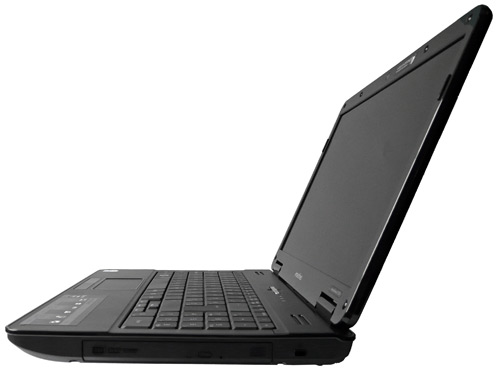
All this is irrelevant, as it's part of Acer now, the world's third
largest PC maker. Many retailers are now simply selling eMachines
products under the Acer eMachines brand, and Acer seems keen on
resurrecting the fallen brand for value minded consumers. It seems do
be doing a pretty good job so far, as over the past year several
affordable models have appeared in the US and EU, including a super
cheap 17-incher for just €399. So, we decided to have a look for
ourselves, and see how of one of Gateway's kids, now in full Acer
custody, is doing.
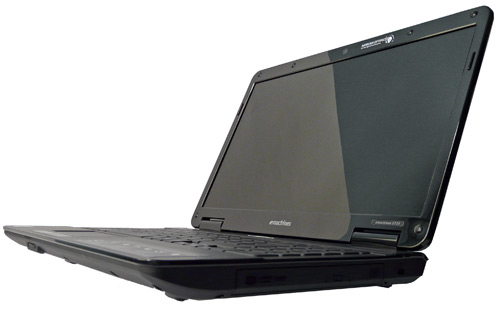
We went for the E725, launched earlier this year, it is the most recent
addition to the companies 15-inch lineup. Unlike most products in this
price range, it features a 16:9 15.6-inch screen. However, unlike most
15.6-inch screens, its resolution is not 1366x768, but rather 1280x768.
More interestingly, it is based on the recently introduced Intel
Pentium dual-core T4200, and this is the main reason we're testing it.
In case you're thinking this is an ancient Merom based part, think
again.
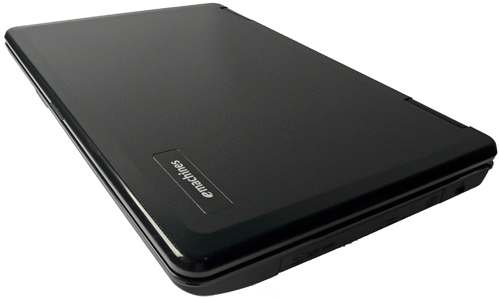
This is where have to deal with more company branding policies,
courtesy of Intel. The T4200 is, in fact, a Penryn based mobile
dual-core, although you wouldn't know that by looking at its
designation. All previous Pentium dual-cores for the notebook world
were either Yonah or Merom based, i.e. they were 65nm parts on a 533MHz
or 667MHz FSB. The T4200, however, is a 45nm chip, and it runs at
2000MHz on an 800MHz bus, which sounds great considering the price.
However, thanks to Intel, most consumers have no idea what the T4200
actually is, and nobody could blame them if they went for a cheap, 65nm
Core 2 Duo, thanks to branding and marketing. As our review will show,
this would be a mistake, a big one.
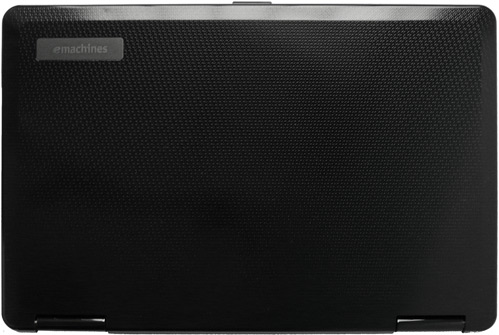
While we're talking hardware, let's take a look at the rest of the spec
before we move on. The eMachines E725 packs a 250GB Western Digital
hard drive, 2GB of Samsung DDR2 at 667MHz, DVD burner, 1280x768 screen,
abg wireless and that's about it. It's a value model, and there's no
FireWire, HDMI or any kind of video out. Oddly, it has just two USBs,
but we'll get round to that in a minute.
Design and Build Quality
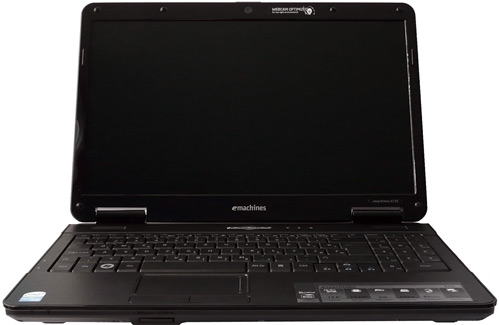
Nobody was obviously trying to hide the E725's Acer heritage, and it
borrows a few design and layout elements from Acer's 15.6-inch Aspire
and Extensa models. Like many 16:9 laptops, it features a numeric
keypad, and its sizable trackpad slightly off center.
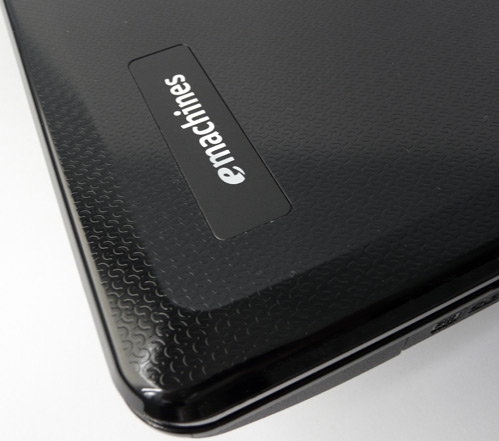
The lid looks interesting and sets it apart from most value products.
Although it sports a glossy black finish, the subtle surface pattern
does a good job keeping fingerprints and smudges away. The glossy black
theme is continued on the panel bezel and the glossy panel itself. Even
the rubber cushions on the bezel are glossy. It actually looks pretty
good, and the bumpy lid is a nice touch, it is both aesthetically
pleasing and useful, as it doesn't get as dirty as ordinary glossy
finish.
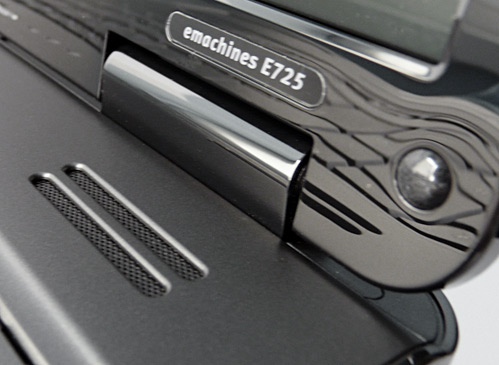
The keyboard and palmrests are made from matte plastic, although not a
very jagged one, and they can easily pick up dirt. Nothing spectacular,
but nothing tacky either, and we're pleasantly surprised by a few cute
details, such as the semi-recesed Power button with a subtle blue
backlight. The bottom of the chassis is crafted from rough and rigid
matte plastic.
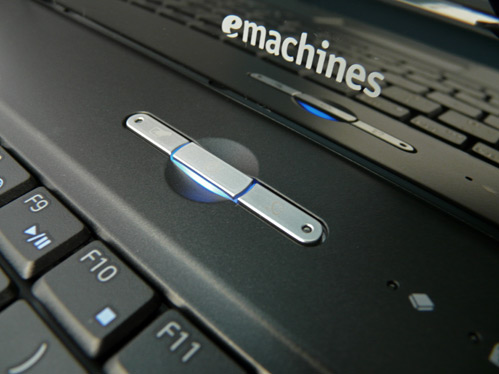
Build quality is average, it's mostly good, but there are a few details
which leave much to be desired, such as the battery latches. When
locked in place, the battery feels a bit shaky, and sometimes you can
hear it move in the bay. The lid feels ok, it doesn't twist much, and
the hinges are solid.
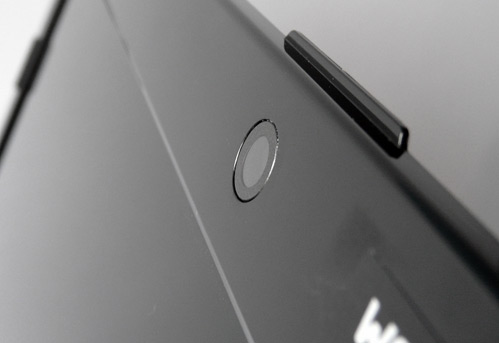
You can see one annoying detail next to
the camera. Usually we'd say it's a good thing to have thumb grip on
the lid, especially if it has a glossy finish, but it's just a bit too
thin and sharp, and doesn't feel sturdy either.
Keyboard and Trackpad
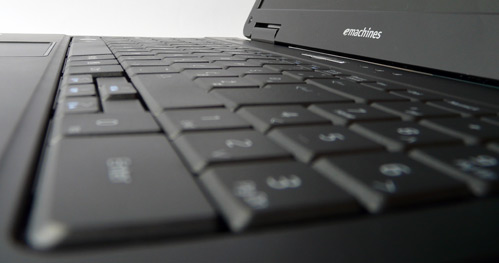
As we said, the E725 features an Acer-esque keyboard with a numeric
pad. The keys are quite large, and they feel good too. There's a hint
of flex, but nothing to serious. Considering the price range, the
quality of the keys themselves is even slightly above average, but the quality of print on them is poor.
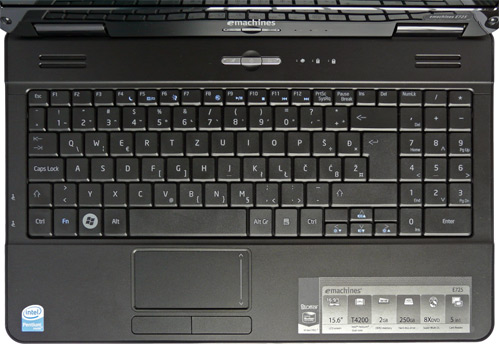
However, the layout could have been better. The arrow keys are half
size, and look like they've come straight off a netbook, not a 16:9
15-incher. On the upside, left Shift, Enter and Backspace are huge.
Some punters love numeric keypads on notebooks, others loath them.
Personally, I don't think they're a very useful feature, but it all
depends on your preferences, and to a lesser extent, your profession. I
don't mind having it, but if a trackpad offset to the right is the
price to pay, I'd rather have a regular keyboard.
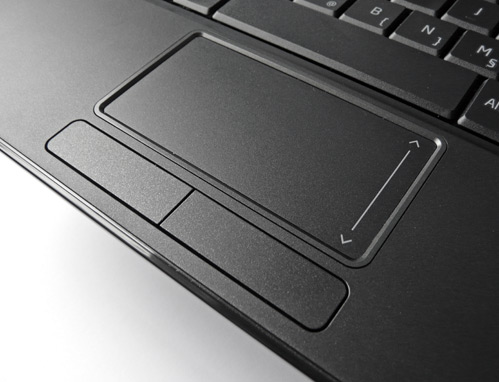
The touchpad is quite big, and it's pretty fast and responive. The keys
feel fine, and they don't have much travel, which is again typical of
Acer.
Ergonomics, Everyday use
Here's where it gets tricky. We already said it has just two USBs, but
they're both on the left side of the chassis. In fact, all of its
connectors are on the left, and when we say all, it's not that many
actually. VGA, LAN, power, audio and the USBs, that's it.

On the right side you'll find the lonely DVD-RW and Kensington.

The front side is also quite clean, with a couple of LEDs and the 5-in-1 memory card reader hidden from prying eyes.

The story repeats at the back.

Obviously the major issue is lack of USB ports, even most netbooks have
three nowadays, and the fact that they're both placed on the left side
is quite odd and awkward. Also, a video out would be nice.
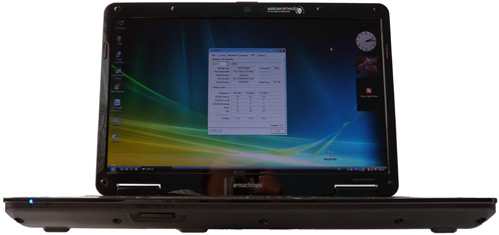
Other than that, the E725 is pretty straightforward, and it's rather
pleasant to use. The screen is good, although the vertical viewing
angle is a bit limited, in the horizontal you'll have plenty of space
to move about. Here is where Acer, or eMachines if you like, saved some
cash. This is the first time we came across a 15.6-inch 16:9 screen in 1280x768. Most vendors offer 1366x768 screens on similar products. It seems consumers like to see a 16:9 sticker on their laptops, but in the end they end up with less pixels than on a standard, low-end 15.4-inch screen.
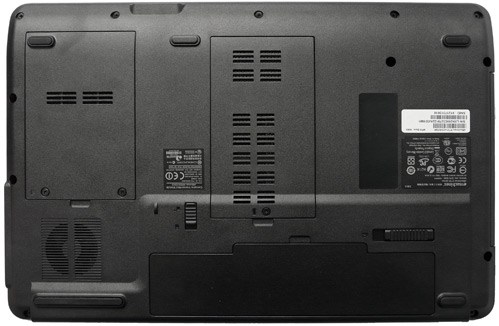
Most products in this market segment suffer from excessive heating, as they're usually based on previous generation dual-cores and obsolescent chipsets. This is not the case with the E725, which stands out thanks to its T4200 45nm CPU and GS45 65nm chipset. It's a pretty cool runner, and therefore it's quiet too.
Battery life was average. The 4400mAh unit managed over 2 hours and 20 minutes in DVD playback. It's still not enough to see Kurtz die in Apocalypse Now Redux, but it's a pretty good score. Obviously you can expect a bit more in regular use, and we were getting over 3 hours easy.
Here's where the T4200 shows what it's made off, and it has nothing to be ashamed off. In most benchmarks it can easily keep up with a 65nm Core 2 Duo on the same clock, and in some tests it even beats it, although by a tight margin. We're comparing it to the recently tested Dell Vostro powered by a T5870.
Cinebench
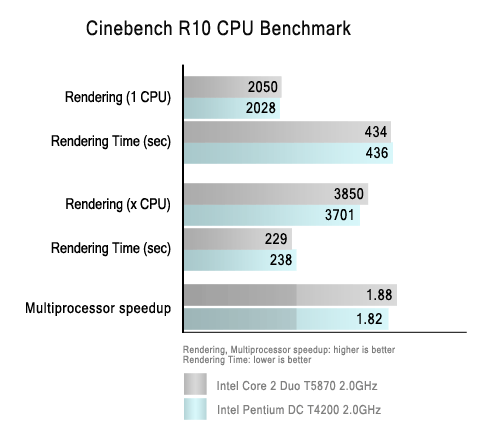
In Cinebench it can keep up with the Core 2 Duo in the single core test, but it doesn't seem to scale as well, so it's left behind in the dual core bench.
SiSoft Sandra
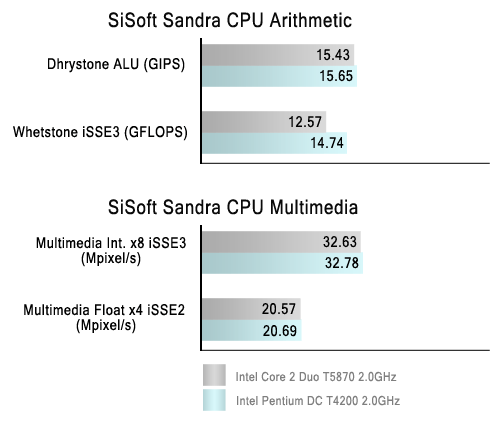
In Sandra, the T4200 beats the T5870, but with a negligible margin.
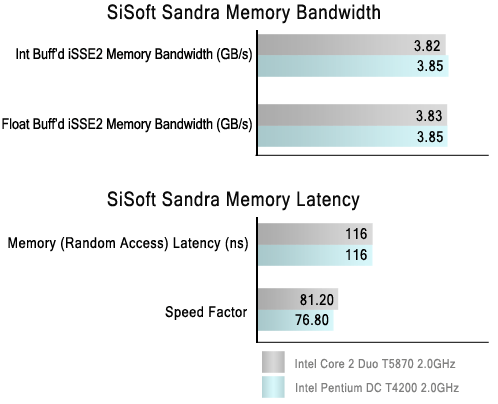
Futuremark 3Dmark 06
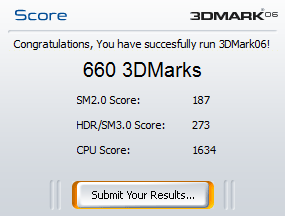
The CPU score in 3D mark 06 is about 4 percent lower compared to the T5870.
HD Tune
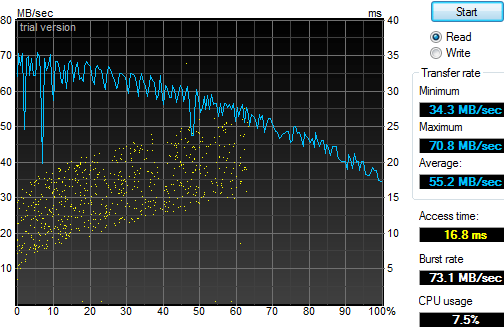
The 250GB HDD is rather fast, although the CPU utilization is a tad higher than expected.
Conclusion
So how is Acer's revival of eMachines going? Not bad actually, although there are a few kinks to address. The E725 is a pretty decent piece of kit and it performs admirably in all benchmarks. Build quality could have been better. The shell shocked battery just ruins the general impression, and the keyboard print job could have been a bit better too. The rest of the chassis feels quite sturdy, and it's no worse than low-end Acers or models from other vendors for that matter. It looks a lot better than previous eMachines models, and if Acer decides to keep this value brand alive, future models should be even better.
We loved the T4200 CPU. It's surprisingly fast, and if you're shopping for a cheap Intel laptop, it's probably the best CPU you can get at the moment. Avoid the T2xx0 and T3xx0 parts, as they're Merom based and you won't even save much money if you go for them. It is as good as any T5xxx Core 2 Duo, but it's a 45nm part, and it's cheaper, too. There is really no reason to insist on a Core 2 Duo in this market segment, and unless you're willing to go for a proper 45nm Core 2 Duo, you can stick with the T4200 and future Penryn based Pentiums.
This E725 SKU appeared in March, and it's not widely available in many markets, and it seems Acer is focusing a bit more attention on emerging markets. A slightly better spec'd SKU, with 4GB of memory, a slightly faster 2.16GHz CPU and 320GB of storage, and Vista Home Premium costs €479, in Germany. This is a pretty good offer, and it's main competition comes from Acer, which sells a similarly spec'd 15.4-inch Extensa SKU for €450. Basically, if you want the numeric keypad and 16:9 screen, go for the eMachines E725. If you prefer a classic keyboard layout and 16:10 screen, go for the Acer.
Either is a pretty good choice, they're affordable and thanks to Intel's latest Penryn based Pentium, performance is impressive for this price point.
